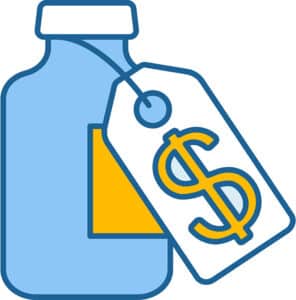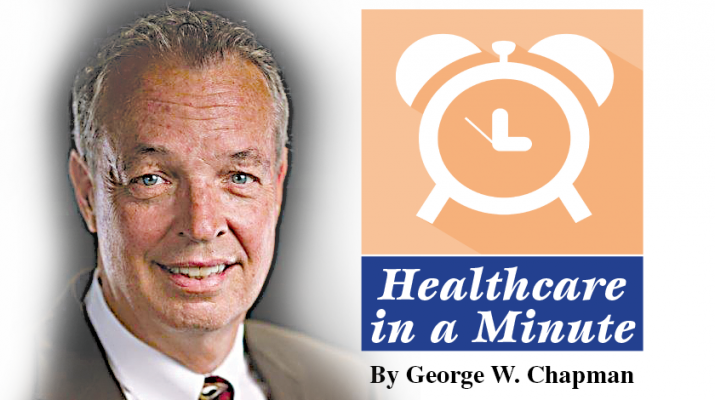by George W. Chapman
 As of this writing in mid-October, more than 70,000 Kaiser Permanente are on strike. This past summer, RUNAP, the Rochester Union of Nurses and Allied Professionals negotiated with Rochester Regional Health. The issues are the same for most hospitals throughout the country. Since COVID-19, thousands of healthcare workers have left their profession, leaving hospitals short staffed. Consequently, active staff are overworked and exhausted. While pay is always an issue, it hasn’t been THE issue. Strikers are mostly concerned with burnout, turnover and patient safety. The dilemma facing just about every private and public hospital is they are operating at razor thin, if not negative, margins. Unlike most businesses, hospitals cannot simply raise prices to increase cash. (Well, they technically can raise prices, but virtually no one will pay them.) Hospital revenues are determined and controlled by Medicare, Medicaid and commercial insurers. I’m sure most hospital executives are sympathetic to union demands. They can see what’s happening as they work there, too. Adding to hospital financial woes are the extravagant fees charged by traveling nurse businesses. If hospitals can’t fill positions locally, they are forced to rely on contract staffing. This just exacerbates the situation as higher paid contract nurses are working side by side with the lower paid local nurses. It’s an HR nightmare. Third party payers are going to have to step up their payments if hospitals are to survive and provide care under safe and competent conditions.
As of this writing in mid-October, more than 70,000 Kaiser Permanente are on strike. This past summer, RUNAP, the Rochester Union of Nurses and Allied Professionals negotiated with Rochester Regional Health. The issues are the same for most hospitals throughout the country. Since COVID-19, thousands of healthcare workers have left their profession, leaving hospitals short staffed. Consequently, active staff are overworked and exhausted. While pay is always an issue, it hasn’t been THE issue. Strikers are mostly concerned with burnout, turnover and patient safety. The dilemma facing just about every private and public hospital is they are operating at razor thin, if not negative, margins. Unlike most businesses, hospitals cannot simply raise prices to increase cash. (Well, they technically can raise prices, but virtually no one will pay them.) Hospital revenues are determined and controlled by Medicare, Medicaid and commercial insurers. I’m sure most hospital executives are sympathetic to union demands. They can see what’s happening as they work there, too. Adding to hospital financial woes are the extravagant fees charged by traveling nurse businesses. If hospitals can’t fill positions locally, they are forced to rely on contract staffing. This just exacerbates the situation as higher paid contract nurses are working side by side with the lower paid local nurses. It’s an HR nightmare. Third party payers are going to have to step up their payments if hospitals are to survive and provide care under safe and competent conditions.
Insurers faring well
 Meanwhile, as cash-strapped hospitals fight the battle, commercial insurers (far from the battlefield) are enjoying, in some cases, record profits. Notable profits for the first half of the year were $11 billion for United and $4 billion for CVS healthcare. Centene, Cigna, Elevance (BCBS) and Humana have all made healthy profits so far this year. Locally, WellNow urgent care is threatening to disenroll from Excellus BlueCross BlueShield effective January 2024 unless they are paid fairly. Excellus has averaged around $130 million profit annually over the last five years. Their rate increases have been around 8% annually over the last five years.
Meanwhile, as cash-strapped hospitals fight the battle, commercial insurers (far from the battlefield) are enjoying, in some cases, record profits. Notable profits for the first half of the year were $11 billion for United and $4 billion for CVS healthcare. Centene, Cigna, Elevance (BCBS) and Humana have all made healthy profits so far this year. Locally, WellNow urgent care is threatening to disenroll from Excellus BlueCross BlueShield effective January 2024 unless they are paid fairly. Excellus has averaged around $130 million profit annually over the last five years. Their rate increases have been around 8% annually over the last five years.
Medicare enrollment
Open enrollment started Oct. 15 and ends Dec. 7. More than half of seniors eligible for Medicare, about 34 million, are enrolled in commercially administered Advantage Plans. The projected rate increase is 4%, but it won’t impact you if your stick with your current plan. Medicare Advantage Plans have been very profitable for commercial carriers.
Costco too?
 Not to be outdone by the likes of Amazon, Walgreens, CVS and Walmart, the giant discounter has partnered with startup Sesame to offer virtual healthcare to its members. The cash-only plan (they don’t accept insurance) will offer virtual primary care at $29 a visit and mental health therapy at $79 a visit via 10,000 participating providers. They are marketing primarily to under insured consumers. Amazon has purchased One Medical for $3.9 billion. CVS bought Oak Street Health for $10.6 billion while Walgreens grabbed Summit Health for $9 billion. While all this money is being invested in primary care, hospitals continue to struggle financially.
Not to be outdone by the likes of Amazon, Walgreens, CVS and Walmart, the giant discounter has partnered with startup Sesame to offer virtual healthcare to its members. The cash-only plan (they don’t accept insurance) will offer virtual primary care at $29 a visit and mental health therapy at $79 a visit via 10,000 participating providers. They are marketing primarily to under insured consumers. Amazon has purchased One Medical for $3.9 billion. CVS bought Oak Street Health for $10.6 billion while Walgreens grabbed Summit Health for $9 billion. While all this money is being invested in primary care, hospitals continue to struggle financially.
Drug co-pay accumulators
In a major victory for patients and consumers, a federal court has struck down a Trump-era policy that allowed insurers not to count any drug manufacturer’s co-pay assistance toward the insured’s out-of-pocket obligation. The now outlawed policy permitted insurers and PBMs to counter the co-pay assistance by raising member annual out-of-pocket obligations. For example, if your co-pay on your diabetic drug was $100 and the manufacturer offered $50 co-pay assistance, the insurer would still consider your co-pay obligation as $100, not $50. The co-pay accumulator is a running tally that tracks what you still owe before reaching your total out of pocket obligation for the year.
Women’s health
 Women comprise 60% of the workforce and face $15 billion more than men in out-of-pocket expenses annually. A survey of 1,200 working women commissioned by Parsley Health revealed why women delay seeking care. 44% delay care due to time constraints; 37% delay care due to disappointment with previous visits; 33% delay care because of co-pays; 24% are worried they will only get another prescription which they do not want; 67% fear being referred to multiple providers and still no definitive diagnosis; and 71% would leave their current position for better health insurance. The survey results are intended to educate and alert employers to the significant healthcare travails facing their female employees.
Women comprise 60% of the workforce and face $15 billion more than men in out-of-pocket expenses annually. A survey of 1,200 working women commissioned by Parsley Health revealed why women delay seeking care. 44% delay care due to time constraints; 37% delay care due to disappointment with previous visits; 33% delay care because of co-pays; 24% are worried they will only get another prescription which they do not want; 67% fear being referred to multiple providers and still no definitive diagnosis; and 71% would leave their current position for better health insurance. The survey results are intended to educate and alert employers to the significant healthcare travails facing their female employees.
Health education vital
In yet another survey seeking to determine patient confidence in their healthcare, OnePoll found that 48% of respondents were anxious about their next appointment, up from 39% in 2022. Insufficient education and information about their condition and symptoms were cited as the major cause of their anxiety. 43% were anxious about being referred to providers they knew nothing about. 32% admitted to Googling their symptoms prior to their visit and 28% worried about their diagnosis. Overall, patient confidence was down due to feeling unempowered. 55% of respondents suggested more education from their provider prior to and during their visit would reduce their anxiety and increase their confidence. 53% said knowing that there is effective treatment would also lower their anxiety and increase their confidence. There is certainly plenty of time spent in waiting rooms that could be better spent on education and patient empowerment.
Nice try
 In yet another victory for consumers, a federal judge has denied a brazen request by the US Chamber of Commerce to delay the deadline requiring drug companies to negotiate drug prices with Medicare. (The deadline was Oct. 1 and negotiations have finally commenced.) The plaintiff tried to argue that the price negotiations authorized by the Inflation Reduction Act were unconstitutional giving the government “illegal and arbitrary price control.” “Control?” Apparently, the clueless chamber (no doubt a straw man put up to challenge the government by the drug manufacturers) couldn’t understand the difference between “negotiating” prices as required by the IRA and “setting–controlling” prices. The plaintiffs also purported negotiations (or “control” as they claim) would result in less access to drugs and less investment in innovation, both of which are hollow and unfounded threats. We are talking about negotiating 10 drugs. Drug manufacturers have long negotiated prices with other countries with national health insurance.
In yet another victory for consumers, a federal judge has denied a brazen request by the US Chamber of Commerce to delay the deadline requiring drug companies to negotiate drug prices with Medicare. (The deadline was Oct. 1 and negotiations have finally commenced.) The plaintiff tried to argue that the price negotiations authorized by the Inflation Reduction Act were unconstitutional giving the government “illegal and arbitrary price control.” “Control?” Apparently, the clueless chamber (no doubt a straw man put up to challenge the government by the drug manufacturers) couldn’t understand the difference between “negotiating” prices as required by the IRA and “setting–controlling” prices. The plaintiffs also purported negotiations (or “control” as they claim) would result in less access to drugs and less investment in innovation, both of which are hollow and unfounded threats. We are talking about negotiating 10 drugs. Drug manufacturers have long negotiated prices with other countries with national health insurance.
 George W. Chapman is a healthcare business consultant who works exclusively with physicians, hospitals and healthcare organizations. He operates GW Chapman Consulting based in Syracuse. Email him at gwc@gwchapmanconsulting.com.
George W. Chapman is a healthcare business consultant who works exclusively with physicians, hospitals and healthcare organizations. He operates GW Chapman Consulting based in Syracuse. Email him at gwc@gwchapmanconsulting.com.

